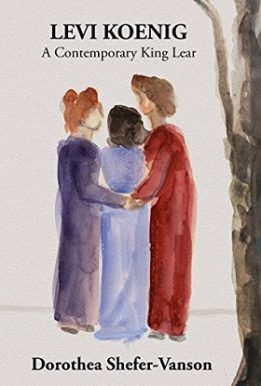LEVI KOENIG
A Universal Dilemma
The Eskimos leave their old people out on the ice to die when they are no longer able to contribute to society. What is the best course to take when dealing with an elderly parent in modern Western society?
The dilemma confronting the three grown-up daughters of Levi Koenig is not an unusual one. Should he be placed in sheltered accommodation, encouraged to live with one or another of his ‘girls,’ or enabled to stay in his own home with a live-in carer?
This situation is not new. Back in the seventeenth century Shakespeare tackled it in his play, King Lear. But was he simply being misogynistic when he depicted two of King Lear’s daughters as grasping, conniving harpies and the third as goodness incarnate? And was King Lear the poor, exploited old man that Shakespeare portrays or really a calculating arch-manipulator? Some aspects of Levi Koenig’s three daughters parallel those of their Shakespearean predecessors, while others do not. Their father also turns out to be a complex, many-sided person, so that matters are far from being black and white.
˃˃˃ Harpies or angels?
The three sisters in Levi Koenig, A Contemporary King Lear are neither harpies nor angels. Like the husbands of two of them (the third is divorced), they are human beings, with human quirks and foibles, both good and bad. With the best of intentions, they set out to find a solution to the problem of their elderly father’s increasing frailty. But as everyone knows, the road to hell is paved with…good intentions. When it transpires that the old man has been sending sums of money to an unknown woman from his past attitudes change and the picture changes drastically.
In addition, each sister has her own issues to contend with, whether it’s an inadequate husband, a drinking problem, demanding children, money troubles, an unfulfilling job, or a failed love affair. Each sister is an individual in her own right, with wishes, motives and plans of her own. And each one makes her own contribution to the unfolding drama. Levi Koenig’s Filipina helper, Flora, adds another element to the mix, with her peculiar English and her own way of looking at things. Past antagonisms and childhood jealousies also come back to haunt the three sisters, further complicating the interaction between them.
˃˃˃ Getting to know them
As the story unfolds we get to know each of the three women more intimately, the daily minutiae of their lives, their thoughts and feelings, and the attitude of each one to herself, her nuclear family, her father, and her sisters. Each one of them is a person with a defined character and her own individual approach to the difficulties that beset her personal life and the extended family unit. Their father makes his own inimical contribution to the course of events, and like the tentacles of an octopus, the ties that bind the family together also restrict their actions and determine the eventual consequences.
˃˃˃ In brief
Levi Koenig, A Contemporary King Learexplores the relations between three grown-up sisters, their attitude to their aged father, and the way each one strives to juggle home, family, work, and love-life while tending to their father’s needs. Their relations come under additional strain when it transpires that their father has been sending money to an unknown woman, turning what seemed initially to be a straightforward situation into a complicated morass. Whether the ending is happy or sad is for the reader to judge.

